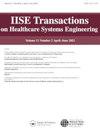使用协变量的相型分布对老年疾病或酒精使用障碍患者的住院时间进行建模
IF 1.5
Q3 HEALTH CARE SCIENCES & SERVICES
IISE Transactions on Healthcare Systems Engineering
Pub Date : 2021-01-10
DOI:10.1080/24725579.2020.1866715
引用次数: 0
摘要
住院时间(LOS)作为衡量医疗服务有效性的重要指标,代表了医疗需求水平,与医疗费用高度相关。由于人类预期寿命在过去几十年中迅速增加,迫切需要改善老年患者的卫生系统。同样,酒精使用障碍(AUD)作为一种与严重问题饮酒相关的慢性复发性脑疾病,对社会造成了负面影响,危及患者的健康和安全。在这两种情况下,由于对长期住院治疗的要求越来越高,医疗费用不断上升,需要更有效的医院管理。为了提高医疗效率,有必要对LOS数据进行准确建模,并进一步分析潜在的影响因素。本文利用Coxian Phase-Type (PH)分布和Maximum Likelihood Estimation (MLE)对某医院收集的老年患者和AUD患者的患者流信息进行拟合。通过期望最大化(EM)算法,评估和比较了年龄、性别、录取类型、录取来源和金融类别等协变量对LOS的影响。结果表明,该方法可以很好地对两类患者的LOS数据进行建模,并且可以准确地识别相对于协变量的差异。利用拟合的协差PH分布和估计的协变量系数将为更好的医疗服务和资源分配决策提供指导。本文章由计算机程序翻译,如有差异,请以英文原文为准。
Modeling the length-of-stay of patients with geriatric diseases or alcohol use disorder using phase-type distributions with covariates
Abstract The hospital length-of-stay (LOS), as an important measure of the effectiveness of healthcare, represents the level of medical requirement and is highly related to the treatment costs. As the human life expectancy has being increased rapidly in the past few decades, there is a pressing need to improve health systems for geriatric patients. Similarly, the alcohol use disorder (AUD), as a chronic relapsing brain disease related to severe problem drinking, has caused negative impacts to society and put patients’ health and safety at risk. In both cases, more efficient hospital management is in demand due to increasing requirements for long-term hospital treatment and the continuously rising medical cost. In order to improve the healthcare efficiency, an accurate modeling of the LOS data and the further analysis of potential influencing factors are necessary. In this paper, we utilize the Coxian Phase-Type (PH) distribution and apply Maximum Likelihood Estimation (MLE) to fit the patient flow information of both geriatric patients and AUD patients collected in a hospital. The influences of the covariates of age, gender, admission type, admit source, and financial class on LOS are assessed and compared through Expectation-Maximization (EM) algorithms. The results show that the LOS data of both types of patients can be modeled well, and the differences with respect to covariates can be accurately identified by the proposed methods. Using the fitted Coxian PH distribution and the estimated coefficients of covariates will provide a guide for better decision-making in healthcare service and resource allocation.
求助全文
通过发布文献求助,成功后即可免费获取论文全文。
去求助
来源期刊

IISE Transactions on Healthcare Systems Engineering
Social Sciences-Safety Research
CiteScore
3.10
自引率
0.00%
发文量
19
期刊介绍:
IISE Transactions on Healthcare Systems Engineering aims to foster the healthcare systems community by publishing high quality papers that have a strong methodological focus and direct applicability to healthcare systems. Published quarterly, the journal supports research that explores: · Healthcare Operations Management · Medical Decision Making · Socio-Technical Systems Analysis related to healthcare · Quality Engineering · Healthcare Informatics · Healthcare Policy We are looking forward to accepting submissions that document the development and use of industrial and systems engineering tools and techniques including: · Healthcare operations research · Healthcare statistics · Healthcare information systems · Healthcare work measurement · Human factors/ergonomics applied to healthcare systems Research that explores the integration of these tools and techniques with those from other engineering and medical disciplines are also featured. We encourage the submission of clinical notes, or practice notes, to show the impact of contributions that will be published. We also encourage authors to collect an impact statement from their clinical partners to show the impact of research in the clinical practices.
 求助内容:
求助内容: 应助结果提醒方式:
应助结果提醒方式:


